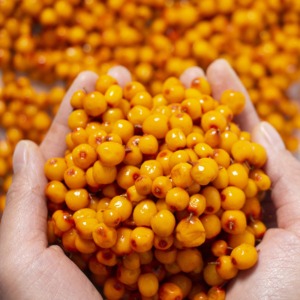Effect of sea buckthorn oil on 3T3-L1 pre-adipocytes proliferation
Cytotoxicity is one key indicator in evaluating the effects of a particular chemical compound on a given cell line. In our study, the Lactate dehydrogenase (LDH) assay was employed to determine the cytotoxicity of sea buckthorn oil on 3T3-L1 preadipocytes. The addition of sea buckthorn oil at specific amounts (from 10−4 to 10−7, V/V) did not induce cellular cytotoxicity, indicating sea buckthorn oil’s safety for a further potential application.
Forming new fat cells through adipogenesis is critical to healthy adipose tissue distribution. Adipogenesis is a tightly regulated process that involves preadipocyte proliferation and adipocyte differentiation. It is well-established that mitotic clonal expansion or proliferation is a prerequisite for adipogenic differentiation in 3T3-L1 cells. The CCK8 assay suggests that 3T3-L1 proliferative ability improved when the cells were treated with 10−6, 10−5, and 10−4 sea buckthorn oil compared to control cells.
 Moreover, cells that received both 10−5 and 10−4 sea buckthorn oil effectively increased their EdU-positive number. The data indicate that sea buckthorn pulp promoted 3T3-L1 preadipocyte proliferation. PCNA is one of the most reliable markers for evaluating cell proliferation ability. Worthy of note, a previous study shows that extracts from sea buckthorn berries increase PCNA expression in acetic acid‐induced gastric ulcers within rats. Compared with control cells, 10−5 and 10−4 sea buckthorn oil treatment increased PCNA mRNA content, with no difference observed between 10−5 and 10−4 sea buckthorn oil treated cells (p<0.05). As anticipated, PCNA protein abundance showed a consistent manner as mRNA expression (p<0.05).
Moreover, cells that received both 10−5 and 10−4 sea buckthorn oil effectively increased their EdU-positive number. The data indicate that sea buckthorn pulp promoted 3T3-L1 preadipocyte proliferation. PCNA is one of the most reliable markers for evaluating cell proliferation ability. Worthy of note, a previous study shows that extracts from sea buckthorn berries increase PCNA expression in acetic acid‐induced gastric ulcers within rats. Compared with control cells, 10−5 and 10−4 sea buckthorn oil treatment increased PCNA mRNA content, with no difference observed between 10−5 and 10−4 sea buckthorn oil treated cells (p<0.05). As anticipated, PCNA protein abundance showed a consistent manner as mRNA expression (p<0.05).
To explore underlying proliferative mechanisms, we measured p38 MAPK protein abundance. Although p38 MAPK protein abundance did not vary among groups, cells received 10−4 sea buckthorn oil showed increased phosphos-p38 MAPK content (p<0.05), and no difference was found between control and 10−5 sea buckthorn oil treated cells. It has been well established that C/EBPβ is necessary for 3T3-L1 preadipocyte proliferation. That DNA binding activity depends on sequential phosphorylation exerted by p38 MAPK and glycogen synthase kinase-3β, and specific inhibitors of p38 mitogen-activated protein kinase block 3T3-L1 adipogenesis. As such, sea buckthorn oil promoted 3T3-L1 preadipocyte proliferation might be possible through activation of p38 MAPK.
Sea buckthorn oil enhanced 3T3-L1 preadipocyte differentiation and mitochondrial biogenesis
Adipogenesis is tightly regulated by several transcriptional factors, with both PPARγ and C/EBPα playing key roles. During this process, early-phase transcription factors, including C/EBPβ and C/EBPδ, activate both C/EBPα and PPARγ expressions, whose expressions in turn transcriptionally activate target genes expression, which characterizes adipocyte phenotype. Cells treated with 10−5 and 10−4 sea buckthorn oil showed more lipid droplets than the control group. Both C/EBPα and aP2 mRNA contents were both elevated in a dose-dependent manner when cells received sea buckthorn oil (control <10−5 <10−4, p<0.05). Compared with control cells, cells subjected to both 10−5 and 10−4 sea buckthorn oil exhibited greater PPARγ mRNA content; there was no difference between 10−5 and 10−4 sea buckthorn oil treated cells (p<0.05). Treated cells with 10−4 sea buckthorn oil increased PPARγ and aP2 protein abundance (p<0.05), whereas no difference was observed in the other two groups. Likewise, sea buckthorn oil treatment effectively increased PPARγ protein levels (p<0.05). Sea buckthorn oil may facilitate adipogenesis by accelerating mitotic clonal expansion by considering the relationship between cell proliferation and adipogenic differentiation.
As the main site for fat storage, healthy adipose tissues prevent ectopic fat accumulation in muscle or liver and enhance insulin sensitivity. Previous studies demonstrate that increased adipocyte expansion or hyperplasia improves insulin sensitivity due to enhanced energy storage capacity of adipose tissues. Constant across results, insufficient adipogenesis from preadipocytes limits adipocyte number and hampers the replacement of dead adipocytes, which are mainly responsible for adipose inflammation and metabolic dysfunction.
Therefore, our data may suggest the positive clinical aspects of sea buckthorn oil. Additionally, white adipose tissue is important endocrine and secretory organ. Adipose tissue actively communicates by sending and receiving different types of signals to perform normal physiological functions. Therefore, the enhanced adipocyte differentiation by sea buckthorn oil might alter physiological functions, details, and mechanisms that require further investigation in animal models.
In the present study, we found that both 10-5 and 10-4 sea buckthorn oil treatments increased mRNA contents of nuclear respiratory factor 1 (NRF-1), mitochondrial transcription factor A (TFAM), and cyclooxygenase-2 (COX2) (p<0.05), suggesting that sea buckthorn oil promoted mitochondria biogenesis. Mitochondria are important for energy metabolism in many tissue types, including skeletal muscle, liver, and adipose tissue. The role of mitochondria in white adipocytes has long been neglected due to their low abundance. Given that various crucial metabolic processes, such as fatty acid oxidation, oxidative phosphorylation, and ROS production, take place in mitochondria, they are essential for maintaining metabolic homeostasis in white adipocytes.
Indeed, mitochondrial dysfunctions in white adipocytes induce whole-body pathological consequences. Our data indicate that sea buckthorn oil increases the number of adipocytes and enhances their energy and metabolic capacity. Moreover, a previous study suggests impaired mitochondrial biogenesis in white adipose tissue is related to insulin resistance. Meanwhile, insulin sensitizer rosiglitazone induces mitochondrial biogenesis and remodeling during 3T3-L1 cell differentiation. Therefore, our results further suggested that sea buckthorn oil could be used as an insulin sensitizer by promoting mitochondria biogenesis.
Sea buckthorn oil stimulated glucose uptake and affected Glut4 expression
Adipocytes play a crucial role in insulin-stimulated glucose uptake, relying on glucose transporter 4. As sea buckthorn oil may increase white adipogenic differentiation potential, we have further explored whether glucose uptake ability was altered. The 2-NBDG assay was employed to evaluate the effect of sea buckthorn oil on glucose uptake. Fluorescence intensity in differentiated adipocytes was enhanced by sea buckthorn oil in a dose-dependent manner (control <10−5 <10−4, p<0.05). The qRT-PCR results indicated that Glut4 mRNA expression was elevated when cells were treated with 10−4 sea buckthorn oil (p<0.05), and there was no difference between control and 10−5 sea buckthorn oil treated cells. As anticipated, adding 10−4 sea buckthorn oil increased the Glut4 protein content (p<0.05). Similarly, a previous study identifies polyphenols from sea buckthorn stimulating glucose metabolism and improving insulin sensitivity.
Sea buckthorn oil addition affected insulin receptor substrate 1 (IRS)/Akt and AMPK activity
To investigate the mechanisms which stimulate glucose uptake and glut4 expression by sea buckthorn oil, the effects of sea buckthorn oil on related cellular signaling pathways were evaluated. Within the well-established insulin-mediated PI3K/Akt pathway, insulin binding to its receptor activates insulin receptor tyrosine kinase, which then induces IRS1 phosphorylation, causing PI3K and Akt activation and leading to GLUT4 translocation and glucose uptake. Adding 10−4 sea buckthorn oil increased phosphorus-IRS1 content (p<0.05). Compared with control cells, phosphorus-Akt levels were elevated when cells were treated with 10−4 sea buckthorn oil (p<0.05). This data suggests that sea buckthorn oil stimulated glucose uptake through activation of the insulin-Akt signaling pathway and is in line with the previous reporting, demonstrating that sea buckthorn fruit oil activates PI3K/Akt signaling pathway in T2DM cells and rats. PPARγ serves as the molecular target for insulin-sensitizing drugs; sea buckthorn oil stimulated PPARγ, which may also contribute to elevated insulin sensitivity.
AMPK is an evolutionary conserved cellular energy sensor; its activation elicits insulin-sensitizing effects, making it an ideal therapeutic target for T2DM. Indeed, various natural extracts and chemicals from herbal medicines promote glucose uptake by activating AMPK. AMPK regulates glut4 transcription by directly phosphorylating histone deacetylase five transcriptional repressor, affecting GLUT4 translocation and glucose transportation activity in 3T3-L1 adipocytes. Although AMPK did not vary among different groups, 10−5 and 10−4 sea buckthorn oil addition effectively elevated phosphorylated AMPK content (p<0.01), which may contribute to elevated glut4 expression and insulin sensitivity. Interestingly, AMPK activity is known to be negatively correlated with adipogenesis ability. The mechanism by which sea buckthorn oil activates AMPK and simultaneously promotes adipogenic differentiation requires further study.
In conclusion, present results suggest that sea buckthorn oil is an insulin sensitizer in adipocytes. Sea buckthorn oil promoted 3T3-L1 preadipocyte proliferation and adipogenic differentiation. While at the same time, sea buckthorn oil increased insulin sensitivity, glut4 expression, and glucose uptake ability, which may occur through activation of Akt and AMPK.

Leave A Comment